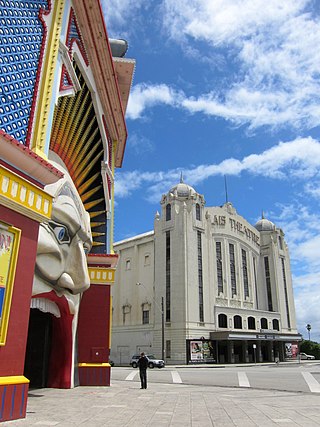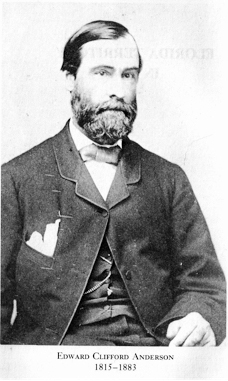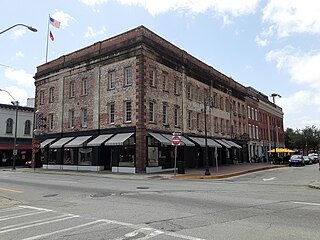
Savannah is the oldest city in the U.S. state of Georgia and is the county seat of Chatham County. Established in 1733 on the Savannah River, the city of Savannah became the British colonial capital of the Province of Georgia and later the first state capital of Georgia. A strategic port city in the American Revolution and during the American Civil War, Savannah is today an industrial center and an important Atlantic seaport. It is Georgia's fifth-largest city, with a 2020 U.S. Census population of 147,780. The Savannah metropolitan area, Georgia's third-largest, had a 2020 population of 404,798.

The French Quarter, also known as the Vieux Carré, is the oldest neighborhood in the city of New Orleans. After New Orleans was founded in 1718 by Jean-Baptiste Le Moyne de Bienville, the city developed around the Vieux Carré, a central square. The district is more commonly called the French Quarter today, or simply "The Quarter", related to changes in the city with American immigration after the 1803 Louisiana Purchase. Most of the extant historic buildings were constructed either in the late 18th century, during the city's period of Spanish rule, or were built during the first half of the 19th century, after U.S. purchase and statehood.

Georgetown is a historic neighborhood and commercial district of Washington, D.C., in Northwest D.C., situated along the Potomac River. Founded in 1751 in the Province of Maryland, the port of Georgetown predated the establishment of the federal district and the City of Washington by 40 years. Georgetown remained a separate municipality until 1871 when the United States Congress created a new consolidated government for the whole District of Columbia. A separate act, passed in 1895, specifically repealed Georgetown's remaining local ordinances and renamed Georgetown's streets to conform with those in the City of Washington.

St Kilda is an inner seaside suburb in Melbourne, Victoria, Australia, 6 km south-east of the Melbourne central business district, located within the City of Port Phillip local government area. St Kilda recorded a population of 19,490 at the 2021 census.

Fitzroy is an inner-city suburb in Melbourne, Victoria, Australia, 3 km (1.9 mi) north-east of Melbourne's Central Business District, located within the City of Yarra local government area. Fitzroy recorded a population of 10,431 at the 2021 census.

Saint James is a district of Port of Spain, Trinidad and Tobago. Port of Spain's last major municipal expansion occurred in 1938, when the St. James district north of Woodbrook and west of St. Clair was incorporated into the city limits. In the late 19th century, Indian indentured labourers on nearby sugar estates established houses here, and St. James gradually became the centre of Port of Spain's Indian population, with many streets named after cities and districts in British India. Western Main Road, the area's major thoroughfare, has long been the city's main nightlife district, sometimes nicknamed "the city that never sleeps".

Old North Columbus is a neighborhood located just north of the Ohio State University in Columbus, Ohio. It was founded in 1847 where, at the time, it was a stand-alone city out of the confines of Columbus until it was incorporated into the City of Columbus in 1871. In its early years the city was a popular stagecoach stop with people traveling from Worthington to Columbus. Today Old North Columbus is popular for its local music and its unique "untouched architecture" which is reminiscent of its old roots.
Gertrude Street is a street in the inner northern suburb of Fitzroy, Melbourne, Australia.
Oglethorpe Barracks usually refers to a 19th-century United States Army post in the historic district of Savannah, Georgia. Some sources use the title to refer to Fort James Jackson or Fort Wayne, both near Savannah. A hotel constructed in the 1880s now sits on the site of the old barracks.

Edward Clifford Anderson Sr. was a naval officer in the United States Navy, Mayor of Savannah, Georgia and a Colonel in the Confederate States Army during the American Civil War. He commanded Fort James Jackson near Savannah before its capture in 1864. He was elected mayor of Savannah eight times, before and after the war, and on December 6, 1865, he became the first mayor to be elected after the war.

The Olde Pink House is a restaurant and tavern in Savannah, Georgia, United States. Located on Abercorn Street, in the northwestern trust lot of Reynolds Square, the building dates from 1771. It is bounded by East Bryan Street to the north, Abercorn Street to the east and East Saint Julian Street to the south.

The Marshall House is a historic building in Savannah, Georgia, United States. It was opened in 1852 by Mary Magdalene Marshall as one of Savannah's first hotels. Located on East Broughton Street, it is the city's oldest operating hotel today, owned by Savannah's HLC Hotels, Inc., which also owns the city's Olde Harbour Inn, the Eliza Thompson House, the East Bay Inn, the Gastonian and the Kehoe House. The building was occupied by the Union Army in 1864 and 1865 during the American Civil War.

Johnson Square is one of the 22 squares of Savannah, Georgia, United States. Located in the northernmost row of the city's five rows of squares, it was the first of the squares to be laid out, in 1733, and remains the largest of the 22. It is east of Ellis Square, west of Reynolds Square and north of Wright Square. Situated on Bull Street and St. Julian Street, it is named for Robert Johnson, colonial governor of South Carolina and a friend of General James Oglethorpe. The oldest building on the square is the Ann Hamilton House, at 26 East Bryan Street, which dates to 1824.

Lafayette Square is one of the 22 squares of Savannah, Georgia, United States. It is located in the fourth row of the city's five rows of squares, on Abercorn Street and East Macon Street, and was laid out in 1837. It is south of Colonial Park Cemetery, west of Troup Square, north of Calhoun Square and east of Madison Square. The square is named for Gilbert du Motier, Marquis de Lafayette, the French hero of the American Revolution who visited Savannah in 1825. The oldest building on the square is the Andrew Low Carriage House, at 329 Abercorn Street, which dates to 1849.

17 Lincoln Street is a historic building in Savannah, Georgia, United States. Located in the northeastern residential block of Reynolds Square, it is one of the city's oldest continuously running bars, having been in operation as such since 1852. Today, it is home to Abe's on Lincoln, a dive bar named for Abraham Lincoln. In a survey for Historic Savannah Foundation, Mary Lane Morrison found the building to be of significant status.

The Thomas Gibbons Range is a building in Savannah, Georgia, United States. Now comprising eight properties, it is located on West Congress Street, in the southeastern civic block of Ellis Square in Savannah's City Market. Built in 1820, it is the oldest building on the square, and the oldest operating commercial building in Savannah. It is part of the Savannah Historic District, and was built, towards the end of his life, for Thomas Gibbons (1757–1826), a planter, politician, lawyer, steamboat owner and the plaintiff in Gibbons vs. Ogden. The building was erected by his son William. Gibbons had owned the lot since 1809.

George Anderson Stores is a historic building in Savannah, Georgia, United States. Located in Savannah's Historic District, the addresses of some of the properties are East Bay Street, above Factors Walk, while others solely utilize the former King Cotton warehouses on River Street. As of February 2022, these are The Peanut Shop of Savannah and Spanky's. The current building was constructed in 1835, but George W. Anderson, a cotton merchant, banker and planter, had a store in the previous incarnation, known as Richard Wayne's Wharf, too. The Andersons were one of Savannah's most prominent families, notably in the Civil War years.

Factors Walk, also commonly spelled Factor's Walk or Factors' Walk, is a historic street in Savannah, Georgia, United States. It runs for about 0.4 miles (0.64 km) along the upper levels of the southern frontages of the buildings of Factors Row, which is located between River Street to the north and Bay Street, around 40 feet (12 m) above on the bluff to the south.

Drayton Street is a prominent street in Savannah, Georgia, United States. Located between Bull Street to the west and Abercorn Street to the east, it runs for about 2 miles (3.2 km) from East Bay Street in the north to East Victory Drive in the south. It is named for Ann Drayton, a member of a noted family in Charleston, South Carolina, who had lent four sawyers to assist colonists in building one of the first homes in Savannah. The street is one-way (northbound). Its northern section passes through the Savannah Historic District, a National Historic Landmark District.

The Lewis Kayton House, also known as the Mansion on Forsyth Park, is a historic five-star hotel at 700 Drayton Street, Savannah, Georgia. It is significant as it was once the home of Lewis Kayton, who was an early pioneer to Savannah in the 19th century. The hotel occupies the Drayton block of the Forsyth Park and is part of the Savannah Historic District. The hotel is now owned by hotel developer Richard C. Kessler, Chairman and CEO of The Kessler Enterprise, Inc.



















